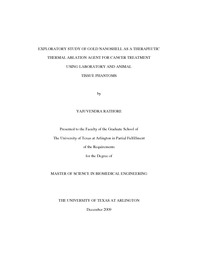
ATTENTION: The works hosted here are being migrated to a new repository that will consolidate resources, improve discoverability, and better show UTA's research impact on the global community. We will update authors as the migration progresses. Please see MavMatrix for more information.
Show simple item record
| dc.contributor.author | Rathore, Yajuvendra | en_US |
| dc.date.accessioned | 2010-03-03T23:30:52Z | |
| dc.date.available | 2010-03-03T23:30:52Z | |
| dc.date.issued | 2010-03-03T23:30:52Z | |
| dc.date.submitted | January 2009 | en_US |
| dc.identifier.other | DISS-10549 | en_US |
| dc.identifier.uri | http://hdl.handle.net/10106/2098 | |
| dc.description.abstract | Prostate cancer is the most common male cancer in the United States and the second leading cause of male death from cancer. Surgical removal of the prostate is associated with high risks of surgical complications and consequences such as incontinence and sexual dysfunction. In my study, I have investigated a nanoparticle-assisted photothermal therapeutic method that may be used for treatment of prostate cancer in the future. This method is minimally-invasive and uses gold nano-shells as hyperthermia agents to treat localized necrosis of cancer cells. I have conducted a feasibility study for a new class of NIR absorbing nanoparticles called Gold Nanoshells for interstitial laser-induced thermal therapy. These are optically tunable nanoparticles, consisting of a dielectric core (silica) coated with an ultrathin metallic layer (gold). These metal coated nanoshells were utilized to convert the absorbed near-infrared light to heat with more efficacy and stability. Extensive study was performed on tissue simulating phantoms in order to examine the temperature profiles. With different concentrations of gold nanoshells, temperature profiles as a function of distance (mm) from the spot of illumination were determined. The phantom study was also aimed to determine the optimal power, concentration of gold nanoshells, and heat spread over vicinity. The results of phantom study were then used to carry out animal tissue study, where direct injections of gold nanoshell suspensions into chicken tissue were performed and rapid heating of gold nanoshell embedded tissues upon exposure to the near infrared light was measured. This procedure will provide the relationship among nanoshell dosages, light intensity, and duration of illumination for tissue damage. The success of this project will be helpful in exploring new treatment techniques (i.e., hyperthermia) for prostate cancer, thus improving the quality of life for prostate cancer patients. Furthermore, this technology can also be applicable to other types of solid tumors/cancers for improved therapeutic outcome. | en_US |
| dc.description.sponsorship | Liu, Hanli | en_US |
| dc.language.iso | EN | en_US |
| dc.publisher | Biomedical Engineering | en_US |
| dc.title | Exploratory Study Of Gold Nanoshell As A Therapeutic Thermal Ablation Agent For Cancer Treatment Using Laboratory And Animal Tissue Phantoms | en_US |
| dc.type | M.S. | en_US |
| dc.contributor.committeeChair | Liu, Hanli | en_US |
| dc.degree.department | Biomedical Engineering | en_US |
| dc.degree.discipline | Biomedical Engineering | en_US |
| dc.degree.grantor | University of Texas at Arlington | en_US |
| dc.degree.level | masters | en_US |
| dc.degree.name | M.S. | en_US |
| dc.identifier.externalLink | https://www.uta.edu/ra/real/editprofile.php?onlyview=1&pid=28 | |
| dc.identifier.externalLinkDescription | Link to Research Profiles | |
Files in this item
- Name:
- Rathore_uta_2502M_10549.pdf
- Size:
- 7.753Mb
- Format:
- PDF
This item appears in the following Collection(s)
Show simple item record


